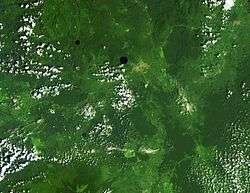Lake Barombi Mbo
| Lake Barombi Mbo | |
|---|---|
 Satellite photo from NASA. Barombi Mbo is the largest circular lake, just above center. | |
| Coordinates | 4°40′N 9°24′E / 4.667°N 9.400°ECoordinates: 4°40′N 9°24′E / 4.667°N 9.400°E |
| Type | Crater lake |
| Primary outflows | Mungo River |
| Basin countries | Cameroon |
| Surface area |
5 square kilometres (1.9 sq mi)[1] or 7 square kilometres (2.7 sq mi)[2][3] |
| Average depth | 69 metres (226 ft)[1] |
| Max. depth | 111 metres (364 ft)[1] |
| Surface elevation | 300 metres (980 ft)[1] |
| Official name | Barombi Mbo Crater Lake |
| Designated | October 8, 2006 [4] |
Lake Barombi Mbo or Barombi-ma-Mbu is a lake near Kumba in the Southwest Region of Cameroon. It is located in the Cameroon volcanic chain, and is the largest volcanic lake in this region.[1] It is one of the oldest radiocarbon-dated lakes in Africa.[5] On old colonial maps the area was known as Elefanten Sea (Elephant Lake), but the elephants living in the area were extirpated due to ivory trading.[6]
Until now, 15 species of fishes have been recorded from the lake.[1] Among others, this includes a member of the Barbus aboinensis group, a member of the Fundulopanchax mirabilis group, and the endemic catfish Clarias maclareni. Perhaps most noteworthy are the 11 species of cichlids that are endemic to the lake (Konia spp., Stomatepia spp., Myaka myaka, Pungu maclareni, Sarotherodon caroli, S. linnellii, S. lohbergeri, and S. steinbachi), and likely the results of sympatric speciation.[7] All the endemics are seriously threatened by pollution and sedimentation from human activities, and potentially also by large emissions of carbon dioxide (CO2) from the lake's bottom (compare Lake Nyos).[2][3][8] Commercial fishing is forbidden in the lake.[2][3][8] Additionally, the lake has an endemic species of sponge (Corvospongilla thysi), and an endemic species of shrimp (Caridina sp.).[1]
See also
References
- 1 2 3 4 5 6 7 Freshwater Ecoregions of the World (2008). Western Equatorial Crater Lakes.
- 1 2 3 Moelants, T. (2009). "Stomatepia mongo". IUCN Red List of Threatened Species. Version 2010.4. International Union for Conservation of Nature. Retrieved 29 April 2011.
- 1 2 3 Moelants, T. (2009). "Konia dikume". IUCN Red List of Threatened Species. Version 2010.4. International Union for Conservation of Nature. Retrieved 29 April 2011.
- ↑ "Ramsar List". Ramsar.org. Retrieved 12 April 2013.
- ↑ Past climate variability through Europe and Africa
- ↑ Elephants and Their Interactions with People and Vegetation in the Waza-Logone Region, Cameroon, Part I Introduction and General Background, 1.1 The Problem, pg 3.
- ↑ Schliewen, U.K., Tautz, D., and Pääbo, S. (1994). Sympatric speciation suggested by monophyly of crater lake cichlids. Nature 368(6472): 629-632.
- 1 2 Moelants, T. (2009). "Konia eisentrauti". IUCN Red List of Threatened Species. Version 2010.4. International Union for Conservation of Nature. Retrieved 29 April 2011.
